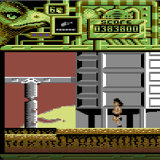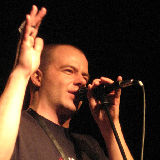 In the 1980s a couple of famous rivalries were fought out in the media and on the playground: Coke vs. Pepsi, Michael Jackson vs. Prince, Commodore 64 vs. the ZX Spectrum. And if you had the former, Rob Hubbard versus Martin Galway.
In the 1980s a couple of famous rivalries were fought out in the media and on the playground: Coke vs. Pepsi, Michael Jackson vs. Prince, Commodore 64 vs. the ZX Spectrum. And if you had the former, Rob Hubbard versus Martin Galway.
During the era of the 8-bit home computer, the Commodore 64 ruled supreme. To this day it remains the best-selling computer model of all time. Part of what made the Commodore 64 great was the fact that its sound chip, named SID, could do more than just produce the odd beep, as it was a fully featured polyphonic synthesizer. In the hurried run up to the release of the computer in 1982, designer Bob Yannes had to make compromises, but the result was still more than competitive. (Yannes later helped make the Ensonic ESQ-1 which did have the features he had originally wanted for the Commodore 64).
Games in those days were often made by and for the British market, and British game music composers were known by name to the public, more so even than the games’ programmers or artists. Everybody had an opinion about which of these composers was better, Rob Hubbard or Martin Galway. Contrarians opted for Ben Dalglish.
And in 1988 the Maniacs of Noise popped onto the scene, two boys from the Netherlands, Charles Deenen from Holthees and Jeroen Tel from Helmond, Noord-Brabant. Deenen was the programming genius who created the machine code sound player, Tel was the composer of numerous tunes such as the theme music for Cybernoid II and Hawkeye (by Dutch software house The Boys Without Brains) and the demo song Kinetix (see above).
In an interview with Tweakers.net last November, Tel said that though he had written hundreds of songs, “all the music I wrote for the Commodore 64 is 750 kilobytes combined when compressed in a RAR file.”
Tel’s attraction for programmable music started with the Casio watch, which had tunes for each day of the week. “I liked the discreteness of it. The discreteness of oscillators. So it turns out this was programmable. Mind blown. This is what I wanted to do.”
Gaming companies knew well how to exploit the teenage heroes that created their properties. Tel said, “you never get royalties. You get a lump sum and that is it. When you make music for films or television, you get paid for the broadcast rights. With games it’s more like, here, have 20,000 euro while we make a billion. And that’s only if you are one of the better composers.”
“I had no business sense, but how was I to know the value of money? What child does? If you had 10 guilders in your hand, right then and there, you were happy. And I was holding 1000 guilders in my hand. I was happy.”
Arriving in 1988 ensured that the name Tel (and that of his colleague, Reyn Ouwehand) was not on the tip of everybody’s tongue. The active life of the Commodore 64 would be another four years, insanely long for any computer platform. People were already getting into 16-bit machines, the first of which, the Apple Macintosh, was introduced in 1984. These new computers had the memory and speed to play long tracks made using samples. Tel nevertheless managed to get his name into the Top 100 List of SID tunes 13 times, twice even in the Top 10.
(Illustration: detail of the game Hawkeye)
 The code $11 does not refer to a dollar amount, but to the value used for selection of the waveform; composers were only allowed to use a triangle wave for this contest.
The code $11 does not refer to a dollar amount, but to the value used for selection of the waveform; composers were only allowed to use a triangle wave for this contest.
 In the 1980s a couple of famous rivalries were fought out in the media and on the playground: Coke vs. Pepsi, Michael Jackson vs. Prince, Commodore 64 vs. the ZX Spectrum. And if you had the former, Rob Hubbard versus Martin Galway.
In the 1980s a couple of famous rivalries were fought out in the media and on the playground: Coke vs. Pepsi, Michael Jackson vs. Prince, Commodore 64 vs. the ZX Spectrum. And if you had the former, Rob Hubbard versus Martin Galway.